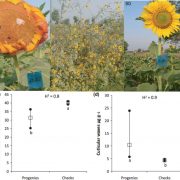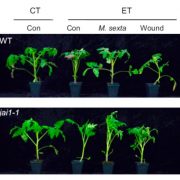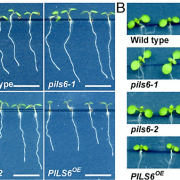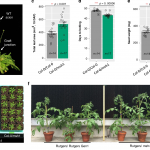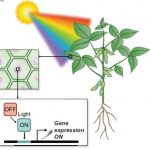The genomic and transcriptomic foundations of viviparous seed development in mangroves (bioRxiv)
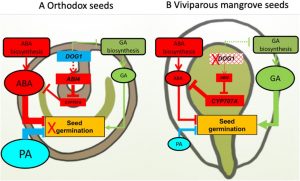 Some mangrove species are viviparous, meaning their seeds germinate while still attached to the mother plant. This behavior is thought to facilitate seedling establishment in the tropical and subtropical intertidal zones they inhabit. However, the genetic and molecular mechanism behind it remains to be described. Here, Qiao and colleagues compare the genome and seed transcriptomic profile of viviparous mangroves and their non-viviparous relatives to look for the potential mechanisms underpinning this phenomenon. Abscisic acid (ABA) and proanthocyanidin (PA) biosynthesis genes were downregulated towards the end of the development of viviparous species seeds. The same trend was observed for gibberellic acid (GA) negative transduction genes. Considering that ABA and PA inhibit germination and GA promotes its, this transcriptomic profile supports why viviparous seeds can germinate immediately after being fully developed. Also, viviparous mangroves lack or have a nonfunctional copy of the DELAY OF GERMINATION1 (DOG1) gene, known for promoting dormancy by inhibiting ABA degradation. Therefore, this research provides an exciting starting point towards unraveling the molecular mechanism responsible for viviparous mangroves. (Summary by Carlos A. Ordóñez-Parra @caordonezparra) bioRxiv 10.1101/2020.10.19.346163
Some mangrove species are viviparous, meaning their seeds germinate while still attached to the mother plant. This behavior is thought to facilitate seedling establishment in the tropical and subtropical intertidal zones they inhabit. However, the genetic and molecular mechanism behind it remains to be described. Here, Qiao and colleagues compare the genome and seed transcriptomic profile of viviparous mangroves and their non-viviparous relatives to look for the potential mechanisms underpinning this phenomenon. Abscisic acid (ABA) and proanthocyanidin (PA) biosynthesis genes were downregulated towards the end of the development of viviparous species seeds. The same trend was observed for gibberellic acid (GA) negative transduction genes. Considering that ABA and PA inhibit germination and GA promotes its, this transcriptomic profile supports why viviparous seeds can germinate immediately after being fully developed. Also, viviparous mangroves lack or have a nonfunctional copy of the DELAY OF GERMINATION1 (DOG1) gene, known for promoting dormancy by inhibiting ABA degradation. Therefore, this research provides an exciting starting point towards unraveling the molecular mechanism responsible for viviparous mangroves. (Summary by Carlos A. Ordóñez-Parra @caordonezparra) bioRxiv 10.1101/2020.10.19.346163


